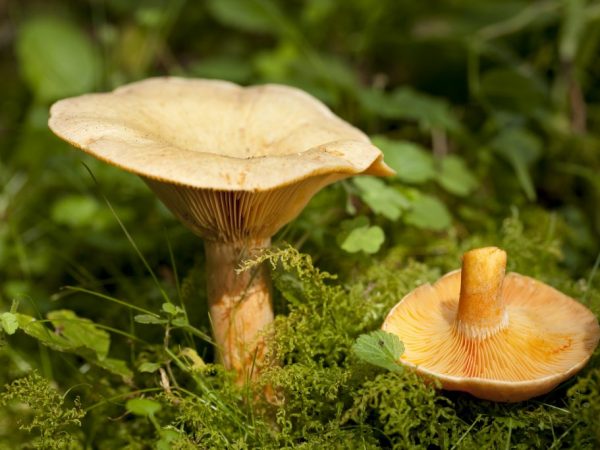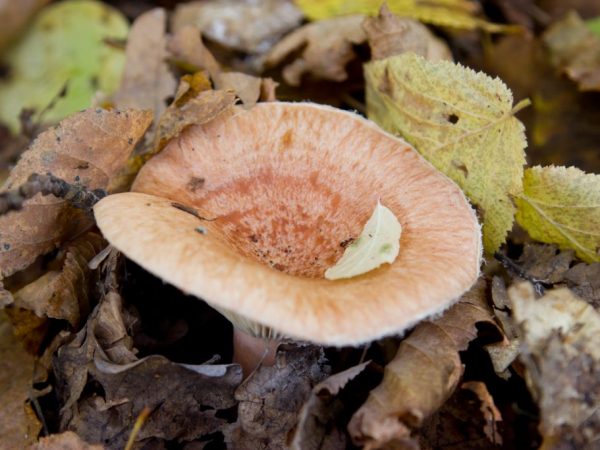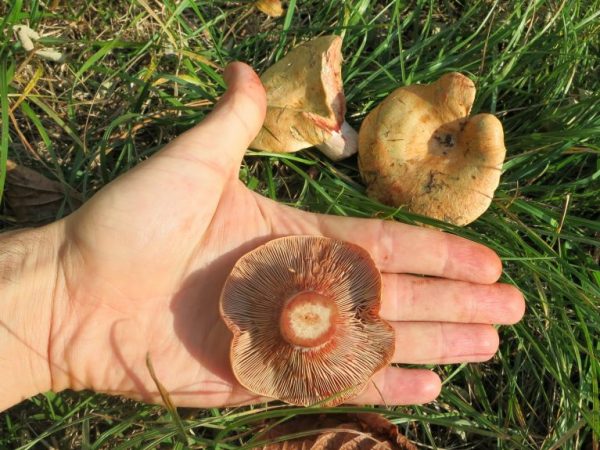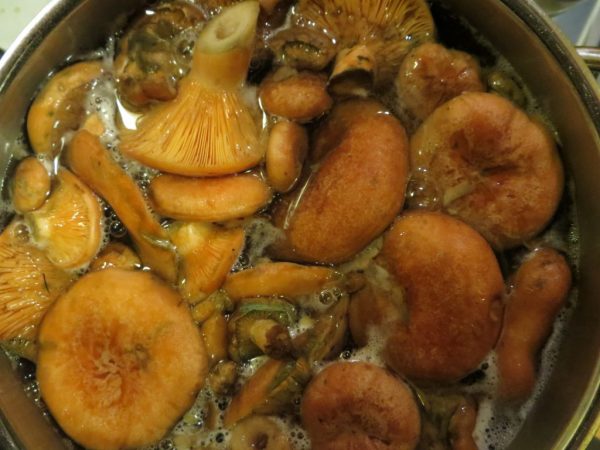What mushrooms look like
Camelina mushrooms are one of the most recognizable of all types of cap mushrooms collected by lovers of "quiet hunting". Studying the features of their growth and distribution helps to harvest and make preparations for the winter.
- The appearance of the mushroom
- Mushroom species
- Present
- Spruce
- Red
- Half red, pine red or green red
- Alpine, or salmon
- Finnish, or blue
- Japanese, or fir
- Dark, dull, or reddish brown
- Wine, or wine red
- Oak
- Beneficial features
- Contraindications
- Application
- In cooking
- In medicine
- Growing methods
- Method 1. Fungal spores
- Method 2. Alternative, with mushroom spores
- Method 3. Planting mycelium
- Conclusion

What mushrooms look like
The appearance of the mushroom
Ryzhiks got this name due to their color. They range from light orange to blue-green.
Hat:
- rounded-convex in young specimens, funnel-shaped in older mushrooms;
- diameter - 3-13 cm;
- the surface is smooth;
- plates are yellow-orange.
The camelina mushroom is characterized by a leg:
- 2-7 cm in height;
- in the form of a regular cylinder;
- 3 cm thick;
- narrowed at the base;
- with small indentations on top.
The pulp of the saffron milk cap is orange, dense, turns green at the break.

Ryzhiks got this name due to the color
Mushroom species
There are different types of saffron milk caps. Winter camelina is an annual plant, it does not belong to mushrooms, it resembles a kind of field grass. The technology of cultivation of spring crops is gaining momentum today.
Present
The real ginger got the names:
- ordinary;
- gourmet;
- pine;
- hog;
- autumn;
- noble.
Ryzhik is called gourmet due to its excellent taste. Gingerbread forms a fungus root (mycorrhiza) with pine. True mushrooms grow on mossy and grassy places among pines, especially near young trees 3-6 m high, where the sun's rays often fall.
Autumn mushroom grows from mid-summer to late October. The collection period for real saffron milk caps is long - July-September.
The pine camelina mushroom, according to the description, has the following features:
- has a resin aroma;
- fleshy cap;
- the cap is equipped with concentric rings, darker in relation to the main background, 4-11 cm in diameter;
- the juice is orange-yellow in color, darkens to a green tint upon contact with air;
- the legs are red, the same color as the cap, there are stripes, notches, rarely a white spot appears.

Ginger has many varieties
Spruce
Spruce mushroom has a second name - green mushroom. A mushroom of the spruce camelina species, like pine camelina, outwardly resemble each other.
Description of spruce mushroom:
- small, fragile;
- the cap is of the same tone, pale, with a bluish-green bloom;
- found among the firs.
It will be possible to meet edible species in mixed forests, areas of artificial planting. The difference between spruce and pine camelina lies in the harvest time: it falls on the end of summer-October.
Red
Red mushroom is an edible mushroom. It differs from all types of saffron milk caps in a more uniform color, with a noticeable red tint.
Description of the appearance of red saffron milk:
- the skin of the cap is orange, shiny, smooth, not sticky;
- there are no spots and concentric zones of a darker shade on the cap;
- the flesh is whitish, has randomly scattered dark red spots;
- milky juice on a cut from red to purple-brown;
- leg with a mealy bloom, covered with red pits.
Red camelina forms mycorrhiza with pines, grows in the Urals, Siberia, and Crimea. Edible species grow in small groups, sometimes frequent. Harvesting falls in mid-summer to November.
Half red, pine red or green red
For half-red saffron milk cap, or p. red pine is characterized by the following distinctive features of appearance:
- milky carrot juice, darkens to wine red;
- the cap is greenish or orange;
- on the cap there are drawings of green circles; in young representatives of the species, they have clearer boundaries;
- when pressed on the cap, it first turns red, then becomes wine-red, then returns to its natural greenish color.
The semi-red camelina species is found in mixed and pine forests, grows rarely or is absent altogether.
Red pine mushroom is usually harvested from mid-summer to October.
Alpine, or salmon
Alpine mushroom is characterized by a bright orange fruit body. Distinctive features of his appearance are:
- a cap up to 22 cm in diameter - the largest among all types of saffron milk caps;
- in color it resembles salmon meat, for which the mushroom received its second name - salmon camelina;
- white pulp in the middle of the mushroom, carrot closer to the surface of the cap;
- the milky juice is orange, stands out abundantly on the cut, the color does not change upon contact with air, neither it nor the pulp.
Alpine mushroom is a delicious species, it grows west of the Urals. Mycorrhiza is formed exclusively with fir, so you need to look for it in those places where this genus of conifers is found.
Collection time is late summer-October.

Alpine has a bright orange color
Finnish, or blue
Representatives of the Finnish camelina species on the territory of Russia are found in Karelia, Arkhangelsk and Vologda regions. Its second name is blue saffron milk cap. The species is characterized by:
- blue flesh when cut;
- the flesh is white in the center, orange at the edges, loose;
- olive, brown hat;
- bright orange plates;
- the milky juice is orange; in air it oxidizes to a greenish-gray.
Finnish mushroom forms mycorrhiza with spruce, grows on light edges.
Harvesting takes place at the end of summer-October.
Japanese, or fir
The species has a different synonym - fir camelina. It is widespread in the Far East (south of the Primorsky Territory), grows in China and Japan. Japanese saffron milk cap is similar to the common saffron milk cap, it differs in:
- a paler color of the skin of the cap;
- the size of the cap, which reaches 6-8 cm in diameter;
- plastics in color are brighter than a hat;
- the flesh is whitish, rarely turns green on the cut, remaining a natural shade;
- the taste of the pulp is insipid.
Mycorrhiza is formed with whole-leaved fir, or black, is found in the territory of mixed forests, which include representatives of this species of trees.
Fruit bodies are harvested from September to October.
Dark, dull, or reddish brown
How dark mushrooms look like:
- the hat is bluish-orange with a gray tint or of a darker color with gray tones;
- in places of damage, the cap turns green;
- the pulp is white, with a sharp taste;
- hymenophore lamellar, orange, turns green when pressed;
- the milky juice is orange, later turns green.
These mushrooms are harvested from late summer to October in mixed and coniferous forests in northern Europe. It is rare on the territory of the Russian Federation. The fungus forms mycorrhiza with pine.
Wine, or wine red
Wine mushrooms resemble flowers of various shades, from magenta to lilac, there are pale and dark on top.
- the cap is non-sticky, smooth, shiny;
- the plates change color from orange in young specimens to wine in color in older specimens;
- the pulp is brittle, white, dense. closer to the skin - wine color;
- the flesh turns reddish-brown or red when it breaks;
- the milky juice is wine-red; on the cut it oxidizes to purple-brown;
- the stem has wine-red fistulas;
- when squeezed, the surface of the leg and cap changes color - it turns blue.
Wine mushrooms grow from the middle of summer; they are also harvested in autumn in the north of Eurasia. The fungus root is formed with pine. The mushroom is somewhat smaller in comparison with representatives of other species.
Oak
Despite the fact that the people call the species "oak mushroom", in fact, this mushroom belongs to milk mushrooms, its exact name is oak milk mushroom. It forms mycorrhiza with hazel, oak, beech. Found in the European part of Russia.
Distinctive features of the oak camelina species:
- light pulp;
- acrid juice, which looks like white milk, not abundant;
- prevalence on soils with clay in the composition;
- small fruit.
Harvesting oak camelina is best from mid-summer to September.
Irina Selyutina (Biologist):
Despite the variety of species, saffron milk caps have common features:
- These are delicate mushrooms that cannot stand cold weather and the optimum temperature for development ranges from + 15 ... + 27 ℃.
- Ryzhiks grow in waves.
- Massively appear from July to September. But you can find them a little later - until November and even small frosts. But these will already be the remnants of the former abundance.
- Ginger loves light spaces, so it settles on the sides of forest roads, forest edges, young plantings of conifers or mossy and grassy glades.
- These mushrooms prefer sandy soils.
- Camelina mushrooms have satellite mushrooms - boletus.
When harvesting, be careful:
- On these mushrooms, a parasite settles - a brick-red pikiella mushroom, which causes a reduction in the plates and makes the mushrooms unsuitable for collection and cooking.
- Camelina mushrooms are often confused with a pink wave, a representative of the same genus Mlechnik, however, belonging to conditionally edible mushrooms. In contrast to saffron milk caps, pink wolf requires careful heat pretreatment (soaking and boiling). It is sometimes called a false mushroom.

Oak camelina forms mycorrhiza with hazel, oak, beech
Beneficial features
Mushrooms are rich in vitamins and minerals. They have a positive effect on the human body, they have:
- beta-carotene, a precursor of vitamin A, which is beneficial for vision;
- cellulose;
- B vitamins;
- ascorbic acid (vitamin C);
- ash substances;
- water;
- saccharides;
- mineral salts.
The benefits of mineral salts are their effect on the skin, hair and nails.
The antibiotic lactrioviolin, found in mushrooms, has useful properties. An interesting fact is that it actively acts and suppresses disease-causing bacteria. Camelina mushrooms are used in the treatment of bacterial diseases, they also help with tuberculosis.
Due to the complete absence of fat and cholesterol, mushrooms are recommended for people with diabetes.
In their composition, 5% belongs to amino acids. Mushrooms are low-calorie - 18 kcal per 100 g. Due to their rich composition, vegetarians actively use them in their diet.
Contraindications
Harmful properties of mushrooms:
- cause constipation;
- after their use, muscle weakness is observed;
- they are not advised to be given to children under 6 years of age.
It is forbidden to use these mushrooms in food for people with gastrointestinal problems, after operations on the gallbladder, its removal. The poisonous counterparts of these species are harmful to any person.
Application
Types of camelina mushrooms are widely used in various fields.
In cooking
Mushrooms are consumed:
- fresh: for this they are doused with boiling water, without processing they are bitter;
- for frying;
- extinguishing;
- pickling;
- salting;
- for freezing.
They are cooked with potatoes, added to okroshka, salads, served as a cold dish, in the form of a sauce for meat.They are distinguished by a rich taste, when properly prepared, they are non-bitter.
It will be possible to freeze the mushrooms after pretreatment. They should be cleaned, washed, but not soaked, worms must be thrown away.

Tasty dishes are made from saffron milk caps
In medicine
The category of these mushrooms treats:
- rheumatism;
- tuberculosis;
- metabolic disorders;
- vitiligo;
- skin diseases.
Gingerbreads are used for insect bites. They are freshly applied to the bite sites, with pain in the joints, boils.
They are great for losing weight, are low in calories, and are well absorbed.
Growing methods
For cultivation, it is worth reproducing the conditions in which mushrooms usually grow in the forest. It is recommended to plant them in the ground under a pine or spruce.
Method 1. Fungal spores
The hats of old mushrooms collected in the forest are finely chopped, dried, scattered above the ground with moisture, covered with soil on top, watered.
Method 2. Alternative, with mushroom spores
Hats with sugar are poured with water, after 24 hours they are softened. Then all this mixture is poured onto the seat. A thin layer of soil is poured on top.
Method 3. Planting mycelium
This method consists in planting a finished mycelium. The mycelium is ordered in a store or dug up independently in the forest. On sale there is a ready-made mycelium, as well as blocks of porcini mushrooms, from which an excellent tubular harvest of boletus is obtained.
For the second option, a 21x21 cm layer is taken around the mushroom body, it is immediately planted. The planting site should be similar to the original in the wild, and constant watering is required. The harvest grows the next year.
Conclusion
Gingerbread is a delicious edible mushroom that prefers to grow under spruce and pine trees. The study of its varieties and their characteristics will allow for a rich harvest.



